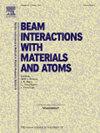苏黎世海水(ZSW) U-和pu同位素比对研究结果
IF 1.4
3区 物理与天体物理
Q3 INSTRUMENTS & INSTRUMENTATION
Nuclear Instruments & Methods in Physics Research Section B-beam Interactions With Materials and Atoms
Pub Date : 2025-05-19
DOI:10.1016/j.nimb.2025.165750
引用次数: 0
摘要
收集约350L的海水样品,制备大体积(Zurich sea water, ZSW)的236U和其他锕系元素比对样品。在这里,我们报告了U-和pu -同位素相互比较研究的结果。ZSW在6个不同的化学实验室进行处理,分别在5个AMS系统和1个MC-ICP-MS系统上进行测量。对报告的铀同位素数据的分析表明,236U/238U比值和236U、238U浓度的散射度(单次测量的1 σ不确定度)分别为5%和3%。卡方分析表明,236、238U浓度和236U/238U比值的外部误差(实验室散射)分别为1 - 2%和3%。ZSW已被许多不同的(A)MS实验室表征,这一事实使其成为分析海水中人为U-和pu同位素的质量控制的有价值的内部标准。本文章由计算机程序翻译,如有差异,请以英文原文为准。
Results from the Zurich sea water (ZSW) intercomparison study for U- and Pu-isotopes
Approximately 350L of sea water samples were collected to prepare a large volume (Zurich Sea Water, ZSW) intercomparison sample for 236U and other actinides. Here we report the results of the intercomparison study for U- and Pu-isotopes. ZSW was processed in six different chemistry labs and measured on five AMS systems and one MC-ICP-MS system, respectively. The analysis of the reported U-isotopic data shows that the scatter, indicated by the one sigma uncertainty for a single measurement, of the 236U/238U ratios and the 236, 238U-concentrations is 5 % and 3 %, respectively. A Chi-squared analysis shows that the external error (lab-scatter) is 1–2 % and 3 % for the 236, 238U-concentrations and the 236U/238U ratios, respectively.
The fact that ZSW has been characterized by many different (A)MS labs makes it a valuable internal standard for quality control for the analysis of anthropogenic U- and Pu-isotopes in seawater.
求助全文
通过发布文献求助,成功后即可免费获取论文全文。
去求助
来源期刊
CiteScore
2.80
自引率
7.70%
发文量
231
审稿时长
1.9 months
期刊介绍:
Section B of Nuclear Instruments and Methods in Physics Research covers all aspects of the interaction of energetic beams with atoms, molecules and aggregate forms of matter. This includes ion beam analysis and ion beam modification of materials as well as basic data of importance for these studies. Topics of general interest include: atomic collisions in solids, particle channelling, all aspects of collision cascades, the modification of materials by energetic beams, ion implantation, irradiation - induced changes in materials, the physics and chemistry of beam interactions and the analysis of materials by all forms of energetic radiation. Modification by ion, laser and electron beams for the study of electronic materials, metals, ceramics, insulators, polymers and other important and new materials systems are included. Related studies, such as the application of ion beam analysis to biological, archaeological and geological samples as well as applications to solve problems in planetary science are also welcome. Energetic beams of interest include atomic and molecular ions, neutrons, positrons and muons, plasmas directed at surfaces, electron and photon beams, including laser treated surfaces and studies of solids by photon radiation from rotating anodes, synchrotrons, etc. In addition, the interaction between various forms of radiation and radiation-induced deposition processes are relevant.

 求助内容:
求助内容: 应助结果提醒方式:
应助结果提醒方式:


